Why is a feasibility study so important in project management? For one, the feasibility study or feasibility analysis is the foundation upon which your project plan resides. That’s because the feasibility analysis determines the viability of your project. Now that you know the importance, read on to learn what you need to know about feasibility studies.
What Is a Feasibility Study?
A feasibility study is simply an assessment of the practicality of a proposed project plan or method. This is done by analyzing technical, economic, legal, operational and time feasibility factors. Just as the name implies, you’re asking, “Is this feasible?” For example, do you have or can you create the technology that accomplishes what you propose? Do you have the people, tools and resources necessary? And, will the project get you the ROI you expect?
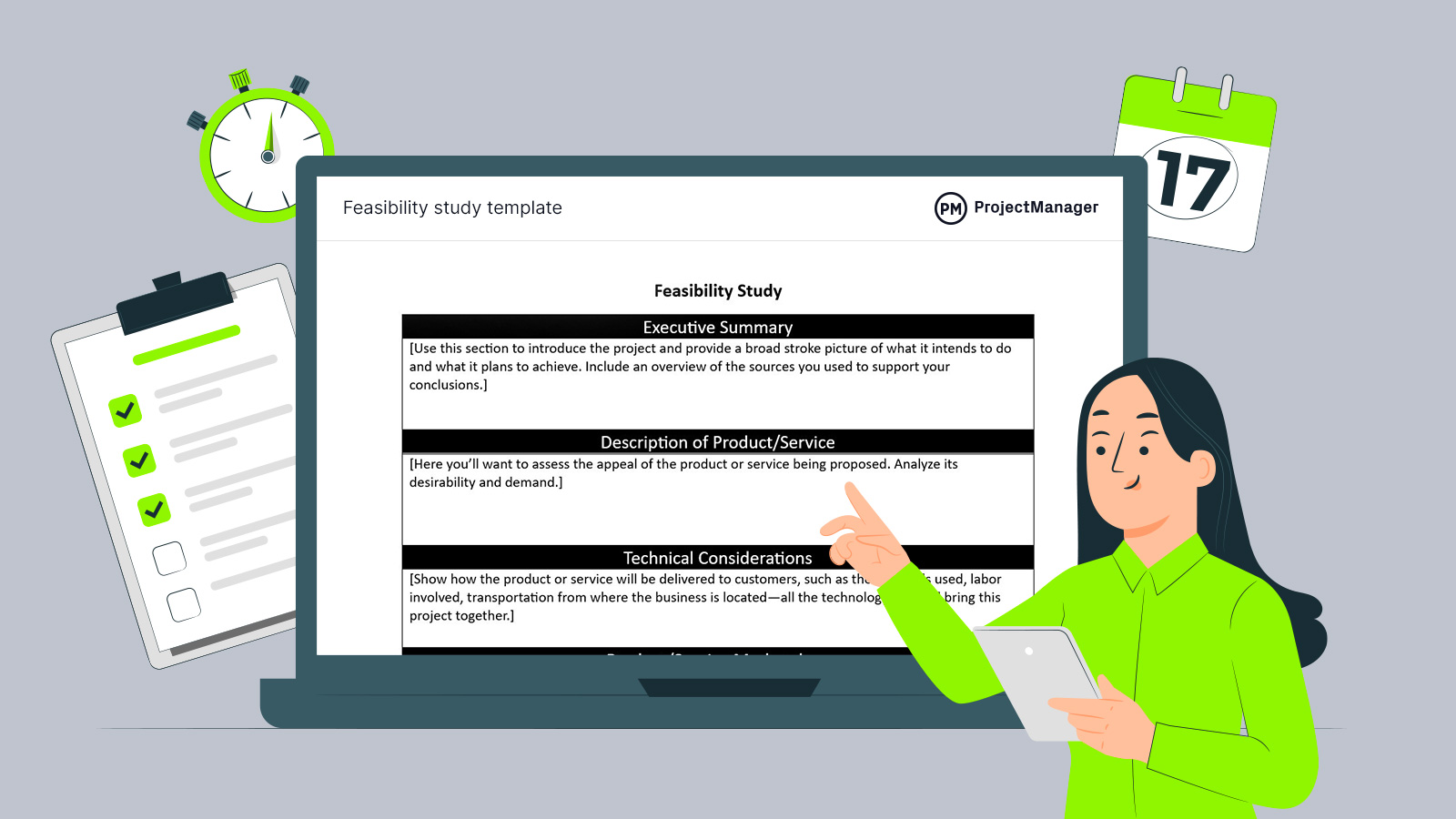
Get your free
Feasibility Study Template
Use this free Feasibility Study Template to manage your projects better.
Get the template
What’s the Importance of a Feasibility Study?
A project feasibility study should be done during the project management life cycle after the business case has been completed. So, that’s the “what” and the “when” but how about the “why?” Why is it important to conduct a feasibility study?
An effective feasibility study points a project in the right direction by helping decision-makers have a holistic view of the potential benefits, disadvantages, barriers and constraints that could affect its outcome. The main purpose of a feasibility study is to determine whether the project can be not only viable but also beneficial from a technical, financial, legal and market standpoint.
What Is Included in a Feasibility Study Report?
The findings of your project feasibility study are compiled in a feasibility report that usually includes the following elements.
- Executive summary
- Description of product/service
- Technology considerations
- Product/service marketplace
- Marketing strategy
- Organization/staffing
- Schedule
- Financial projections
- Findings and recommendations
Free Feasibility Study Template
Use this free feasibility study template for Word to begin your own feasibility study. It has all the fundamental sections for you to get started, and it’s flexible enough to adapt to your specific needs. Download yours today.
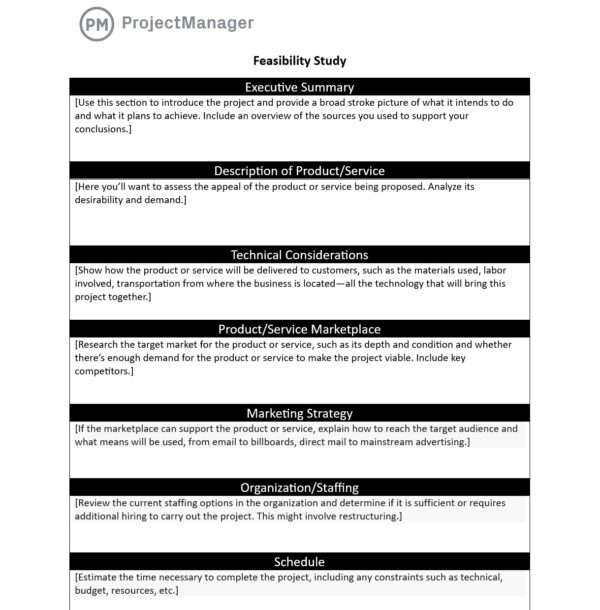
Types of Feasibility Study
There are many things to consider when determining project feasibility, and there are different types of feasibility studies you might conduct to assess your project from different perspectives.
Pre-Feasibility Study
A pre-feasibility study, as its name suggests, it’s a process that’s undertaken before the feasibility study. It involves decision-makers and subject matter experts who will prioritize different project ideas or approaches to quickly determine whether the project has fundamental technical, financial, operational or any other evident flaws. If the project proposal is sound, a proper feasibility study will follow.
Related: Project Proposal Template
Technical Feasibility Study
A technical feasibility study consists in determining if your organization has the technical resources and expertise to meet the project requirements. A technical study focuses on assessing whether your organization has the necessary capabilities that are needed to execute a project, such as the production capacity, facility needs, raw materials, supply chain and other inputs. In addition to these production inputs, you should also consider other factors such as regulatory compliance requirements or standards for your products or services.
Economic Feasibility Study
Also called financial feasibility study, this type of study allows you to determine whether a project is financially feasible. Economic feasibility studies require the following steps:
- Before you can start your project, you’ll need to determine the seed capital, working capital and any other capital requirements, such as contingency capital. To do this, you’ll need to estimate what types of resources will be needed for the execution of your project, such as raw materials, equipment and labor.
- Once you’ve determined what project resources are needed, you should use a cost breakdown structure to identify all your project costs.
- Identify potential sources of funding such as loans or investments from angel investors or venture capitalists.
- Estimate the expected revenue, profit margin and return on investment of your project by conducting a cost-benefit analysis, or by using business forecasting techniques such as linear programming to estimate different future outcomes under different levels of production, demand and sales.
- Estimate your project’s break-even point.
- Conduct a financial benchmark analysis with industrial averages and specific competitors in your industry.
- Use pro forma cash flow statements, financial statements, balance sheets and other financial projection documents.
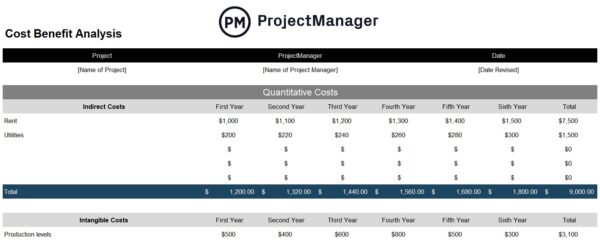
Legal Feasibility Study
Your project must meet legal requirements, including laws and regulations that apply to all activities and deliverables in your project scope. In addition, think about the most favorable legal structure for your organization and its investors. Each business legal structure has advantages and disadvantages when it comes to liability for business owners, such as limited liability companies (LLCs) or corporations, which reduce the liability for each business partner.
Market Feasibility Study
A market feasibility study determines whether your project has the potential to succeed in the market. To do so, you’ll need to analyze the following factors:
- Industry overview: Assess your industry, such as year-over-year growth, identify key direct and indirect competitors, availability of supplies and any other trends that might affect the future of the industry and your project.
- SWOT analysis: A SWOT analysis allows organizations to determine how competitive an organization can be by examining its strengths, weaknesses and the opportunities and threats of the market. Strengths are the operational capabilities or competitive advantages that allow an organization to outperform its competitors such as lower costs, faster production or intellectual property. Weaknesses are areas where your business might be outperformed by competitors. Opportunities are external, such as an underserved market, an increased demand for your products or favorable economic conditions. Threats are also external factors that might affect your ability to do well in the market such as new competitors, substitute products and new technologies.
- Market research: The main purpose of market research is to determine whether it’s possible for your organization to enter the market or if there are barriers to entry or constraints that might affect your ability to compete. Consider variables such as pricing, your unique value proposition, customer demand, new technologies, market trends and any other factors that affect how your business will serve your customers. Use market research techniques to identify your target market, create buyer personas, assess the competitiveness of your niche and gauge customer demand, among other things.

7 Steps to Do a Feasibility Study
If you’re ready to do your own feasibility study, follow these 7 steps. You can use this free feasibility study template to help you get started.
1. Conduct a Preliminary Analysis
Begin by outlining your project plan. You should focus on an unserved need, a market where the demand is greater than the supply and whether the product or service has a distinct advantage. Then, determine if the feasibility factors are too high to clear (i.e. too expensive, unable to effectively market, etc.).
2. Prepare a Projected Income Statement
This step requires working backward. Start with what you expect the income from the project to be and then what project funding is needed to achieve that goal. This is the foundation of an income statement. Factor in what services are required and how much they’ll cost and any adjustments to revenues, such as reimbursements, etc.
Related: Free Project Management Templates
3. Conduct a Market Survey or Perform Market Research
This step is key to the success of your feasibility study, so make your market analysis as thorough as possible. It’s so important that if your organization doesn’t have the resources to do a proper one, then it is advantageous to hire an outside firm to do so.
Conducting market research will give you the clearest picture of the revenues and return on investment you can realistically expect from the project. Some things to consider are the geographic influence on the market, demographics, analyzing competitors, the value of the market and what your share will be and if the market is open to expansion (that is, in response to your offer).
4. Plan Business Organization and Operations
Once the groundwork of the previous steps has been laid, it’s time to set up the organization and operations of the planned project to meet its technical, operational, economic and legal feasibility factors. This isn’t a superficial, broad-stroke endeavor. It should be thorough and include start-up costs, fixed investments and operating costs. These costs address things such as equipment, merchandising methods, real estate, personnel, supply availability, overhead, etc.
5. Prepare an Opening Day Balance Sheet
This includes an estimate of the assets and liabilities, one that should be as accurate as possible. To do this, create a list that includes items, sources, costs and available financing. Liabilities to consider are such things as leasing or purchasing land, buildings and equipment, financing for assets and accounts receivables.
6. Review and Analyze All Data
All of these steps are important, but the review and analysis are especially important to ensure that everything is as it should be and that nothing requires changing or tweaking. Take a moment to look over your work one last time.
Reexamine your previous steps, such as the income statement, and compare them with your expenses and liabilities. Is it still realistic? This is also the time to think about risk and come up with any contingency plans.
7. Make a Go/No-Go Decision
You’re now at the point to make a decision about whether or not the project is feasible. That sounds simple, but all the previous steps lead to this decision-making moment. A couple of other things to consider before making that binary choice are whether the commitment is worth the time, effort and money and whether it aligns with the organization’s strategic goals and long-term aspirations.
Feasibility Study Examples
Here are some simple feasibility study examples so you have a better idea of what a feasibility study is used for in different industries.
Construction Feasibility Study
For this construction feasibility study example, let’s imagine a large construction company that’s interested in starting a new project in the near future to generate profits.
- Pre-Feasibility Study: The first step is to conduct a preliminary feasibility study. It can be as simple as a meeting where decision-makers will prioritize projects and discuss different project ideas to determine which poses a bigger financial benefit for the organization.
- Technical Feasibility Study: Now it’s time to estimate what resources are needed to execute the construction project, such as raw materials, equipment and labor. If there’s work that can’t be executed by the company with its current resources, a subcontractor will be hired to fill the gap.
- Economic Feasibility Study: Once the construction project management team has established what materials, equipment and labor are needed, they can estimate costs. Cost estimators use information from past projects, construction drawings and documents such as a bill of quantities to come up with an accurate cost estimate. Then, based on this estimate, a profit margin and financial forecasts will be analyzed to determine if there’s economic feasibility.
- Legal Feasibility Study: Now the company needs to identify all potential regulations, building codes and laws that might affect the project. They’ll need to ask for approval from the local government so that they can begin the construction project.
- Market Feasibility Study: Market feasibility will be determined depending on the nature of the project. For this feasibility example, let’s assume a residential construction project will be built. To gauge market potential, they’ll need to analyze variables such as the average income of the households in the city, crime rate, population density and any trends in state migration.
Manufacturing Feasibility Study
Another industry that uses feasibility studies is manufacturing. It’s a test run of the steps in the manufacturing production cycle to ensure the process is designed properly. Let’s take a look at what a manufacturing feasibility study example would look like.
- Feasibility Study: The first step is to look at various ideas and decide which is the best one to pursue. You don’t want to get started and have to stop. That’s a waste of time, money and effort. Look at what you intend to manufacture, does it fill an unserved need, is the market able to support competition and can you manufacture a quality product on time and within your budget?
- Financial Feasibility Study: Find out if your estimated income from the sale of this product is going to cover your costs, both direct and indirect costs. Work backward from the income you expect to make and the expenses you’ll spend for labor, materials and production to determine if the manufacturing of this product is financially feasible.
- Market Feasibility Study: You’ve already determined that there’s a need that’s not being served, but now it’s time to dig deeper to get realistic projections of revenue. You’ll want to define your target demographic, analyze the competitive landscape, determine the total market volume and what your market share will be and estimate what market expansion opportunities there are.
- Technical Feasibility Study: This is where you’ll explore the production, such as what resources you’ll need to produce your product. These findings will inform your financial feasibility study as well as labor, material, equipment, etc., costs have to be within your budget. You’ll also figure out the processes you’ll use to produce and deliver your product to the market, including warehousing and retail distribution.
There could be other feasibility studies you’ll have to make depending on the product and the market, but these are the essential ones that all manufacturers have to look at before they can make an educated decision as to whether to go forward or abandon the idea.
Best Practices for a Feasibility Study
- Use project management software like ProjectManager to organize your data and work efficiently and effectively
- Use templates or any data and technology that gives you leverage
- Involve the appropriate stakeholders to get their feedback
- Use market research to further your data collection
- Do your homework and ask questions to make sure your data is solid
If your project is feasible, then the real work begins. ProjectManager helps you plan more efficiently. Our online Gantt chart organizes tasks, sets deadlines, adds priority and links dependent tasks to avoid delays. But unlike other Gantt software, we calculate the critical path for you and set a baseline to measure project variance once you move into the execution phase.
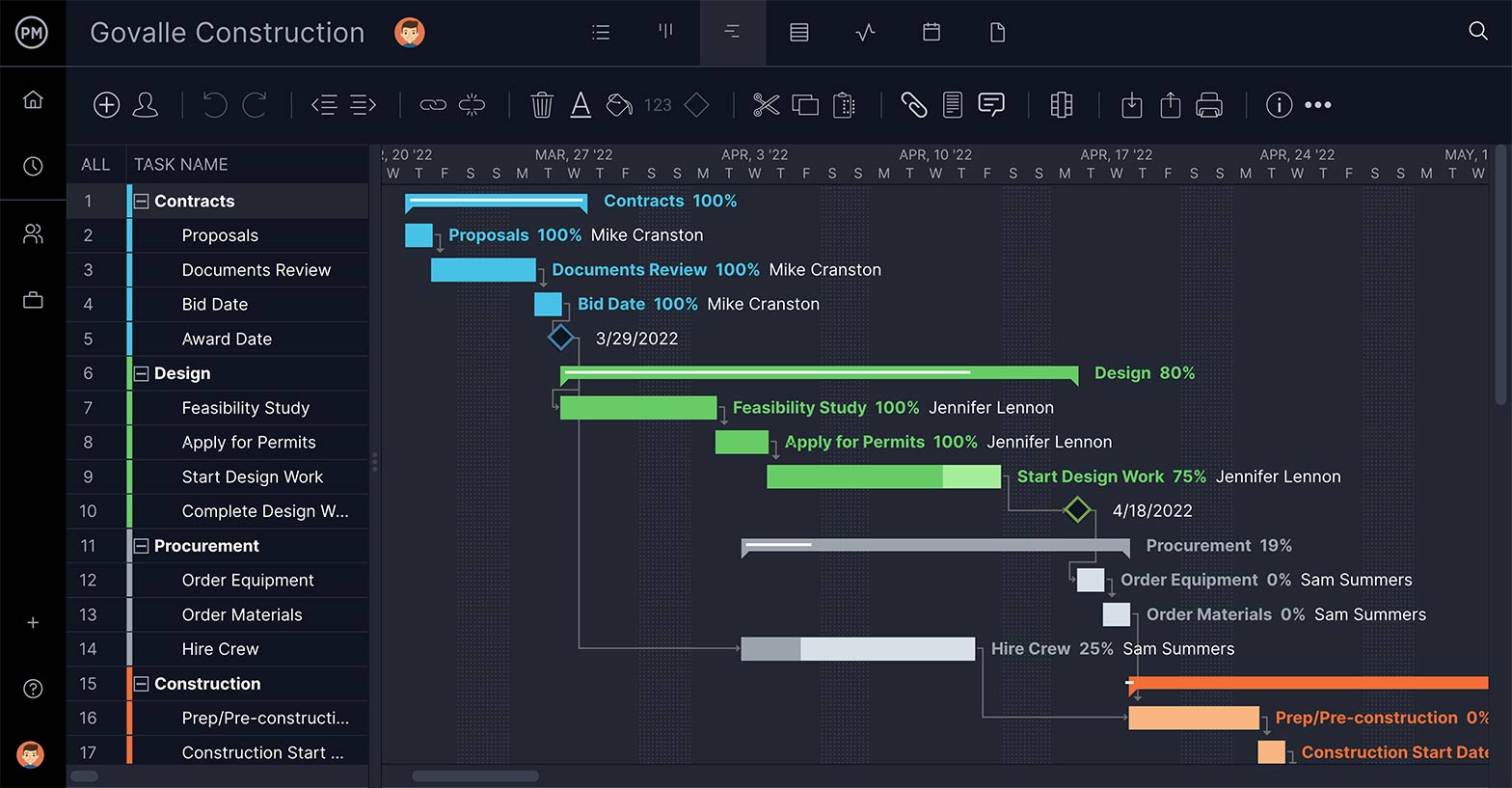
Watch a Video on Feasibility Studies
There are many steps and aspects to a project feasibility study. If you want yours to be accurate and forecast correctly whether your project is doable, then you need to have a clear understanding of all its moving parts.
Jennifer Bridges, PMP, is an expert on all aspects of project management and leads this free training video to help you get a firm handle on the subject.
Here’s a screenshot for your reference!
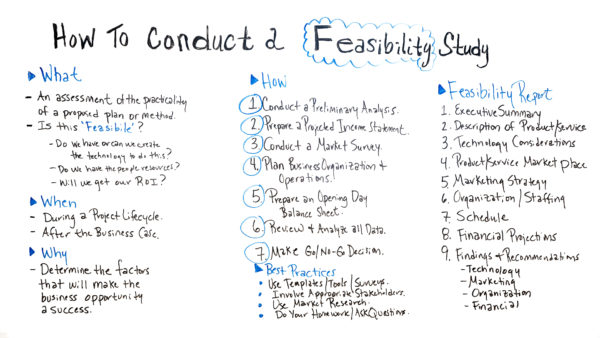 Thanks for watching!
Thanks for watching!
Pro tip: When completing a feasibility study, it’s always good to have a contingency plan that you test to make sure it’s a viable alternative.
ProjectManager Improves Your Feasibility Study
A feasibility study is a project, so get yourself a project management software that can help you execute it. ProjectManager is an award-winning software that can help you manage your feasibility study through every phase.
Once you have a plan for your feasibility study, upload that task list to our software and all your work is populated in our online Gantt chart. Now you can assign tasks to team members, add costs, create timelines, collect all the market research and attach notes at the task level. This gives people a plan to work off of, and a collaborative platform to collect ideas and comments.
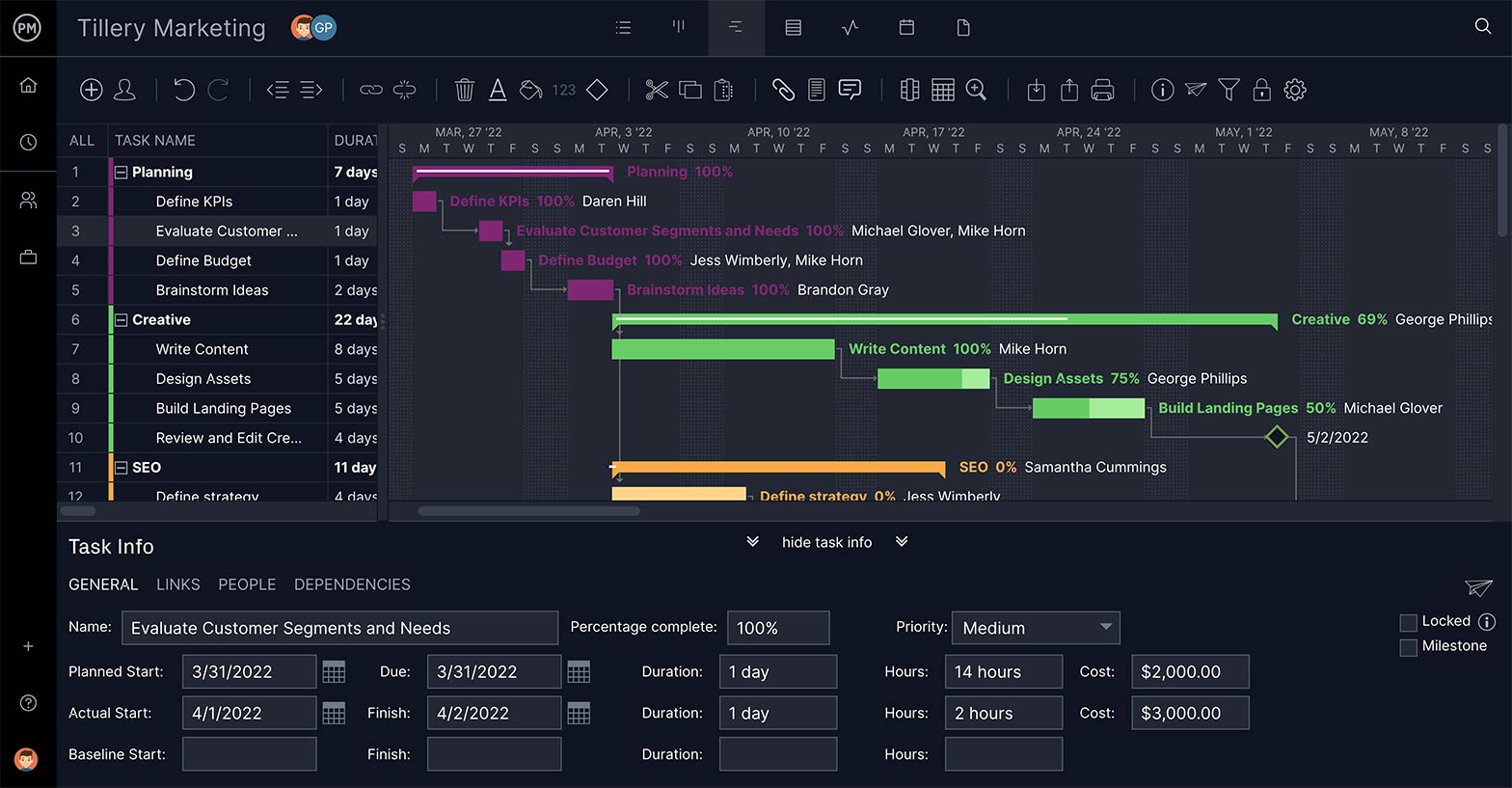
If you decide to implement the project, you already have it started in our software, which can now help you monitor and report on its progress. Try it for yourself with this free 30-day trial.
Transcription
Today we’re talking about How to Conduct A Feasibility Study, but first of all, I want to start with clarifying what a feasibility study is.
Feasibility Analysis Definition
Basically, it’s an assessment of the practicality of a proposed plan or method. Basically, we’ll want to want to know, is this feasible. Some of the questions that may generate this or we can hear people asking are, “Do we have or can we create the technology to do this? Do we have the people resource who can produce this and will we get our ROI, our Return On Investment?”
When to Do a Feasibility Study
So when do we do the feasibility study? So it’s done during a project lifecycle and it’s done after the business case because the business case outlines what we’re proposing. Is it a product or service that we’re proposing?
So why do we do this? The reason we do this is that we need to determine the factors that will make the business opportunity a success.
How to Conduct a Feasibility Study
Well, let’s talk about a few steps that we do in order to conduct the feasibility study.
Well, first of all, we conduct a preliminary analysis of what all’s involved in the business case and what we’re analyzing and what we’re trying to determine is feasible.
Then we prepare a projected income statement. We need to know what are the income streams, how are we gonna make money on this. Where’s the revenue coming from? We also need to conduct a market survey.
We need to know, is this a demand? Is there a market for this? Are customers willing to use this product or use this service?
The fourth one is to plan the business organization and operations. What is the structure, what kind of resources do we need? What kind of staffing requirements do we have?
We also want to prepare an opening day balance sheet. What are the…how again, what are the expenses, what’s the revenue and to ensure that being able to determine if we’re gonna make our ROI.
So we want to review and analyze all of the data that we have and with that, we’re going to determine, we’re going to make a go, no-go decision. Meaning, are we going to do this project or this business opportunity or not.
Well, here are some of the best practices to use during your feasibility study.
One is to use templates, tools and surveys that exist today. The great news is, data is becoming more and more prevalent. There are all kinds of technologies. There are groups that they do nothing but research. Things that we can leverage today.
We want to involve the appropriate stakeholders to ensure that input is being considered from the different people involved.
We also want to use again the market research to ensure we’re bringing in good, reliable data.
Do your homework, meaning act like is if this is your project, if it’s your money. So do your homework and do it well and make sure you give credible data.
What Is a Feasibility Report?
So ultimately in the end what we’re doing is, we’re producing and we’re providing a feasibility report. So in that report, think of this is like a template.
So what you’re gonna do is give it an executive summary of the business opportunity that you’re evaluating and the description of the product or the service.
You want to look at different technology considerations. Is it technology that you’re going to use? Are you going to build the technology?
What kind of product and service marketplace and being able again, to identify the specific market you’re going to be targeting? Also, what is the marketing strategy you’re going to use to target the marketplace?
And also what’s the organizational structure? What are the staffing requirements? What people do you need to deliver the product or service and even support it?
So also we want to know the schedule to be able to have the milestones to ensure that as we’re building things, that as we’re spending money that we’re beginning to bring in income to pay and knowing when we’re going to start recuperating some of the funding. Again, which also ties into the financial projections.
Ultimately in this report, you’re going to provide the findings and the recommendations.
Again, we’ll probably talk about technology. Are you going to build it? Are you going to buy it? What are the marketing strategies for the specific marketplace organization? You may have some recommendations for whether you’re going to insource the staff, maybe you are going to outsource some staff and what that looks like and also financial recommendation.
Related Content
There’s a lot to learn in project management before you can plan, schedule, execute and deliver projects successfully. For this reason, we’ve created dozens of blogs, templates, ebooks and videos on the most important topics in project management. Here are some of them.
- 20+ Project Management Tools & Techniques
- Best Project Management Certifications
- Project Management Basics: Definitions, Methods and Tools
- 100+ Project Management Terms: PM Terminology
- PMBOK: The Project Management Body of Knowledge Explained
- Top 15 Project Management Methodologies: An Overview
- Best Project Management Charts for Project Planning
- ¿Qué es el Estudio de Viabilidad de un Proyecto?
- Qu’est-ce qu’une étude de faisabilité ? Comment en réaliser une pour votre projet
- Was ist eine Machbarkeitsstudie? Wie man eine durchführt
If you’ve been looking for an all-in-one tool that can help with your feasibility study, consider ProjectManager. We offer five project views and countless features that make it seamless to plan projects, organize tasks and stay connected with your team. See what our software can do for you by taking this free 30-day trial.

